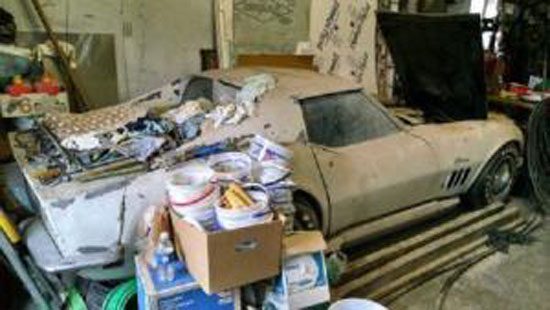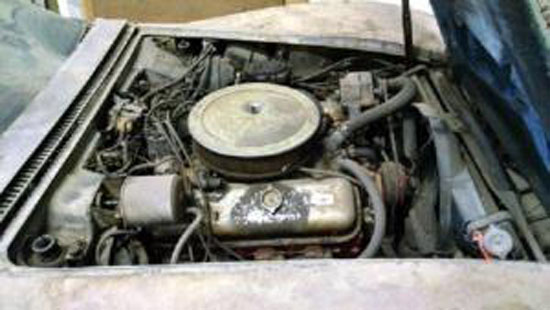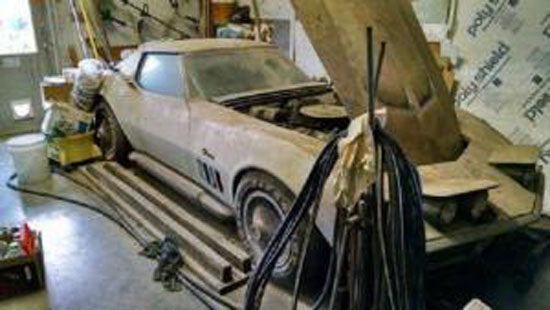
by Sarah Shelton as republished from corvettes.about.com
Worthy Investment for a Corvette Collector or Money Pit?
Dateline November 2015: The clandestine barn find: many classic car enthusiasts daydream that they will unearth such a mythical beast. That they will happen upon a rare specimen that’s been hidden from view for decades, dusty and neglected in some darkened corner. Corvette barn finds can certainly be a gratifying treasure, both to discover and to restore. But the costs required to bring the car back to a roadworthy condition or to show quality should not be overlooked. These expenses often separate a worthy investment from a money pit.
This 1969 Corvette Stingray was recently up for sale in an eBay listing, and I wanted to take a closer to look to see if it was a great barn find or an overpriced project car.

This 1969 Corvette Stingray is for sale after being stored for 27 years. Photos via eBay.
1969 Corvette Stingray Barn Find
Rescued from an Indiana garage, the last time this C3 saw the city streets, George Michael’s “Faith” was a pop sensation and Ronald Reagan held his last year in the White House. The owner doesn’t explain why the Stingray has been locked away since 1988, but layers of dust coating the paint appear to corroborate his timeline.
According to the eBay listing, this 1969 Corvette still has its original matching numbers 427, 390 horsepower engine and automatic transmission. In fact, the seller says that the Stingray is “all original.” And only 31,441 miles have been turned on the odometer (also said to be the car’s actual mileage).
Specs on the rest of the car are scant. The only other bit included on the Stingray’s auction listing is “Trim pkg. ZQ4” and “Plant Assembly 984-B18.”
The starting bid for the car was $20,000, with a higher (though undisclosed) reserve.
The Condition
With almost three decades of dust coating the Corvette, it’s a little difficult to ascertain the full extent of the damages. But it’s clear that this car is going to need more than a little spit and polish.
Let’s start with the good: I’m happy to see that the 427 and Stingray chrome badges are still attached, along with both side-mounted exhaust pipes and at least two of the upgraded wheel covers. The body panels that are visible in the photos appear straight with no major dents or rust.
The exterior is far from pristine, which is understandable. Paint appears to be flaking off along the rear body panels and B-pillars. The rear deck has been converted to a storage, collecting tools and other miscellaneous garage junk.
I don’t see any tears in the seats, but with only two grainy photos of the interior, it’s almost impossible to see what kind of condition the dash, carpeting and headliner are in.
Underneath the hood, it’s presumed that the stickers shown on the air cleaner and valve cover are original. Dust and grease have converted all engine surfaces to sepia tones, and it’s disconcerting that the owner doesn’t mention whether the engine is operational or not.
In 1969, the base Corvette was delivered with a 350 V-8 engine. According to the auction listing, this Stingray has been upgraded to the L36, a 390-horspower V-8 and one of four 427 cubic inch engines available that year. The automatic transmission, a Turbo Hydra-Matic 3-speed, was an option installed in 8,161 of the year’s total 38,762 Corvettes produced.
Deluxe wheel covers were an inexpensive $57.95 upgrade that year, and were ordered on only 20 percent of 1969 Corvettes. Trim package ZQ4 refers to the black interior, the base vinyl color for the year. Only 4,355 side-mounted exhaust systems were installed by the factory in 1969, making this one of the more rare additions on this Stingray.
Looking at the VIN (posted as 194379S702017), this car was one of the first 1969 Corvettes produced, rolling off the line in September 1968. Side-mounted exhaust and the chrome emblems are still on this 1969 Corvette Stingray barn find.
Estimating its Value
For the last five years, values of 1969 Corvettes have held mostly steady, though they have dipped slightly. But this year may be one of the most desirable C3 models to own. For many, 1969 marked the apex of the muscle car age. Models released by Detroit’s Big Three — including the Dodge Challenger and Charger, the Ford Mustang and the Chevrolet Camaro — emulate the aggressive designs iconic of the era with the power to back it up. The 1969 Corvette Stingray bridged the gap between sports car and muscle car to secure a place in both categories.
Looking at this Corvette in particular, it has a few standout features that will add to its value.
This Stingray’s 427 V-8 is neither the most powerful nor the rarest engine available in 1969. And about one third of all 1969 Corvettes came with the L36. For collectors, the higher horsepower L71 and L88 427 engines are typically more desirable. However, the L36 does add a few thousand dollars (and maybe as much as $7,000) to the Corvette’s overall value.
The side-mounted exhaust is also a sought after add-on for collectors, adding $1,000 to $2,000 to the price.
Condition, obviously, is this car’s biggest downfall. Of course, that comes with the territory for mores barn finds. Because the car suffered from neglect for 27 years, it will never be a good candidate as an original “survivor.”
As it sits, this Corvette is probably worth around $11,500. But it has much potential. If the engine and transmission are truly original, they will add significantly to this Corvette’s value after it has been restored.
With restoration — depending on the quality level and extent of the work — the value will likely fall between $20,000 and $35,000. Last year a similar 1969 Stingray (with the same L36 engine and a four-speed transmission, both original) sold in a Mecum auction for $35,000. A chrome badge notes that this 1969 Corvette Stingray is powered by a 427 V-8 engine.
Final Notes
As it sits, this 1969 Corvette Stingray appears to be overpriced for its condition. Buyers should not get starry-eyed with the car’s “matching numbers” and be tempted to overpay, especially when beautiful, fully-restored Stingrays can be bought for only $15,000 more. An owner could easily invest much more than $15,000 to refurbish the body, interior and mechanics on this C3.
If this Corvette is in running condition or the owner could be talked down in price, than this classic Stingray may be worth considering. As it stands, though, I wouldn’t call this Corvette a good deal.

